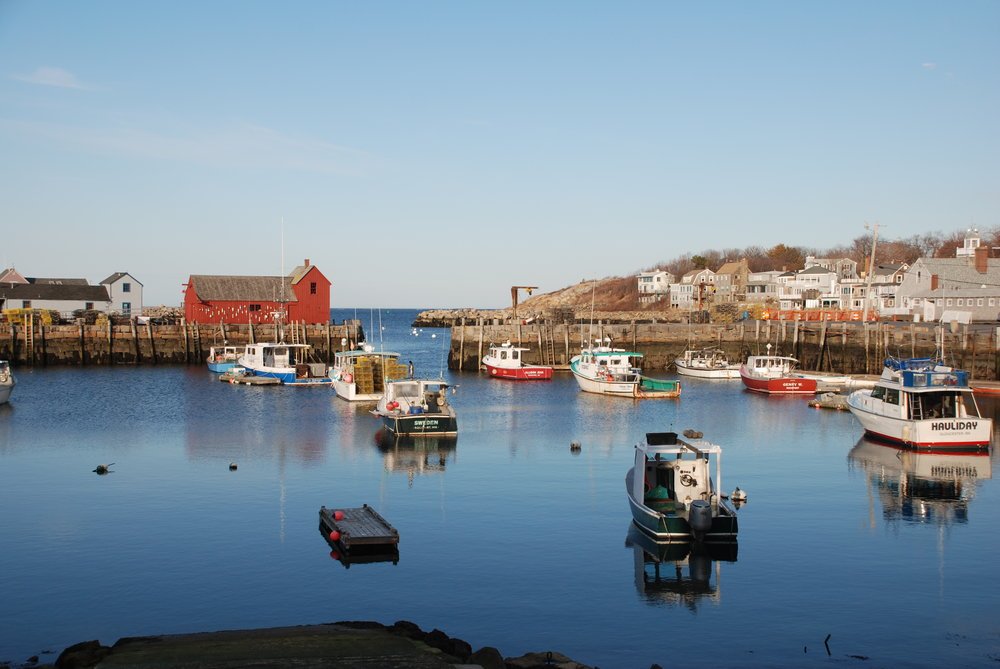
Welcome to Rockport
Rockport is primarily a suburban residential and tourist town, but it is still home to a number of lobster fishermen and artists. Its rocky beaches and seaside parks are a favorite place for tourists from the Greater Boston Area and Rhode Island among other places.
Key Details
Settled - 1623
Incorporated - 1840
County - Essex
Zip code - 01966
Area
Total - 17.5 sq mi (45.4 km2)
Land - 7.0 sq mi (18.1 km2)
Water - 10.5 sq mi (27.3 km2)
Population (2010)
Total - 6,952
Density - 400/sq mi (150/km2)
Resources
-
Transportation
There are no highways within the town, but two state routes, Route 127 and Route 127A pass through town. Route 127 passes from north to south through town, entering inland from Gloucester, passing over Great Hill before following the sea from Back Harbor to Halibut Point and then back. Route 127A follows the southern coast into town, looping around Land's End, Gap Head and the downtown area before reaching its northern terminus at Route 127. Bus service in Rockport is provided by the Cape Ann Transportation Authority. Rockport is also the last station on its eponymous branch of the Newburyport/Rockport Line of the MBTA Commuter Rail, providing service along the North Shore to Boston's North Station. The nearest airport is the Beverly Municipal Airport, with the nearest national and international service at Boston's Logan International Airport.
History
Before the coming of the English explorers and colonists, Cape Ann was home to a number of Native American villages, inhabited by members of the Agawam tribe. Samuel de Champlain named the peninsula "Cap Aux Isles" in 1605, and his expedition may have landed there briefly. By the time the first Europeans founded a permanent settlement at Gloucester in 1623, most of the Agawams had been killed by diseases caught from early contacts with Europeans.
Richard Tarr, a granite cutter and the first settler of the Sandy Bay Colony, lived in the area that is now Rockport in 1680. He and his wife Elizabeth had ten children, those born after 1690 were recorded in the Sandy Bay Colony record books. Richard died around the year 1732. (The source provided by "History of the Town of Gloucester, Cape Ann" by John J. Babson, Published by the Proctor Brothers 1860. Printed by John Wilson and Son, 22 School Street, Boston, MA. This history book account is still available online.) The area provided timber for shipbuilding, especially pine, and granite was extracted from the Sandy Bay quarries. The Cape Ann area provided one of the richest fishing grounds in New England and in 1743 a dock was built at Rockport harbor on Sandy Bay and was used for both timber export and fishing. By the beginning of the 19th century, the first granite quarries were developed, and by the 1830s, Rockport granite was being shipped to cities and towns throughout the East Coast of the United States.
Rockport had consisted primarily of large estates, summer homes, and a small fishing village while Gloucester was becoming increasingly urbanized. Rockport was set off as a separate town in 1840 as its residents desired a separate enclave with an identity of its own, and was incorporated in 1840. As the demand for its high-grade granite grew during the Industrial Revolution, the quarries of Rockport became a major source of the stone. A distinctive form of sloop was even developed to transport the granite to parts far and wide until the second decade of the 20th century. For many years, there was a large number of residents of Scandinavian descent, dating from the days when Finnish and Swedish immigrants with stone-working expertise made up a large part of the workforce at the quarries.
Although the demand for granite decreased with the increased use of concrete in construction during the Great Depression, Rockport still thrived as an artists colony—which began years earlier due in part to its popularity as a vacation spot known for its rocky, boulder-strewn ocean beaches, its history as a prominent fishing harbor, and its mentions in media like that of Rudyard Kipling's Captains Courageous. A red fishing shack on Bradley Wharf in Rockport, known popularly as "Motif Number 1", has for years been one of the most famous sites on Cape Ann as the subject of hundreds of paintings and photographs, and is visited by aspiring artists & tourists alike from all over the world. Rockport is the home of the Rockport Art Association.
In 1856, a gang of 200 women led by Hannah Jumper swept through the town and destroyed anything containing alcohol in what is called "Rockport's revolt against rum" and banned alcohol from the town. Except for a period in the 1930s, the town remained one of 15 Massachusetts dry towns. The town remained dry for many years until 2005, when it was voted that alcohol could be served at restaurants, but liquor stores are still illegal.
In 1933, the Rockport American Legion Post. No. 98 built a 27-foot (8.2 m) scale model of "Motif No.1" for the Legion Parade, which was held in Chicago, Illinois, site of the 1933 World's Fair. Designed by Aldro Hibbard and Anthony Thieme, with participation by the RAA, Board of Trade and townspeople "from high to low", the float was commissioned in June, completed by the end of September, and driven in daylight only, from Rockport to Chicago, in less than a week. On October 3, 1933, among 200 floats, it won first place in the historic float competition. Upon the float's return to Rockport, a crowd of over 4,000 people lined up and down the Great Hill (5 corners) to welcome the float home.
The Labor Movement in Rockport Quarries
Rockport, especially the Pigeon Cove area, has historically been home to many immigrant communities, notably Finns, Swedes, Italians, and Portuguese immigrants. Scandinavian immigrants often worked in the quarries, located at what is now Halibut Point State Park. Mediterranean immigrants arrived in the Early Republic, and the first Finnish and Swedish immigrants in the 1870s. Finns and Swedes were often lumped together as one group, and as Historian Jonathan Schwartz suggests, “a generalized "Scandinavian" identity for the Swedish and Finnish immigrants, at least in the eyes of the New England community. These ethnic divisions were important pieces of working-class identities, and became more important as quarry workers become more involved in labor activism against the Rockport Granite Company, which first opened on Feb. 10, 1865, and dissolved on Dec. 31, 1933.
From March to June of 1899, for example, a group of Finnish quarrymen, who were the newest immigrant groups brought in to work in the quarries, went on strike. Originally, Finns were brought to Pigeon Cove and the Rockport Granite quarries to break strikes in the early 1990s, but eventually became one of the most militant groups to fight for worker's rights. The 1899 strike was supported by the National Granite Cutters Union and the Quarry Workers Union, allegedly due to contract violations. This strike was particularly heated, with violence and arrests throughout the conflict. The Boston Globe provided many reports of the Finns being particularly strong labor activists, refusing to cut deals and threatening those who tried to go to work during the strikes. The Rockford Granite Company attempted to bring in Italian laborers from Boston to act as strikebreakers or scabs in the spring of 1899. These temporary workers were housed in shanties near Blood Ledge quarry at Bay View, about half a mile from the quarry. The Finnish workers had heard about the Italian scabs and attempted to communicate that they were on strike and hoped that the Italians would join their cause. According to The New York Times, the Italian workers had been brought to the quarry “under false pretenses” and about half of them abandoned work. However, the remainder of the Italian strikebreakers felt threatened, and the Rockford Granite Company requested police protection for the remaining strikebreakers.
On May 10th, 1899, a number of Finnish strikers were arrested for their labor activism. On April 20, 1899, a group of two hundred Finns rallied and worked its way to the quarry shanties, armed with clubs and stones, eventually converging on the Italian scabs that had taken refuge in the boiler house, even going so far as to pull the shutters off the building. Eventually, the strikers dispersed when one member was shot in the foot. The Italian worker groups were quite frightened of the Finnish strikers, and many of them ended up heading back to Boston after this incident.
On June 8th, 1899, a bombing, suspected by police to be the work of strikers or someone invested in the strike, destroyed one of the company buildings inhabited by a John Nelson and six other workers who refused to join the strike. Fortunately, the workers were uninjured. Three Finns were arrested under suspicion of the crime. They later fled Rockford to avoid trial.
Eventually, the Finns and their fellow strikers would win the right to a nine-hour work day and time and a half for overtime work, and assurances that the company would not discriminate against any of the over 2,000 workers who participated in the strike. During the early years of the twentieth century, quarry workers would strike for other rights with the support of their unions, notably in 1902, 1908, and 1916. The quarries eventually closed down operations in the Great Depression. Two explanations are possible for the closing of the quarry – the introduction of new building materials such as poured concrete and quarry worker’s continued movement for better working conditions and wages into the 1920s. Swedish and Finnish workers continued to work in the quarries until their closure, and have left a distinct mark on the cultural heritage of Rockport.
-
Harbourmaster, 1957–1958 adventure/drama television series, starring Barry Sullivan; set in Lockport
Coma (1978)
I'll Be Home for Christmas (1988)
Mermaids (1990)
The Good Son (1993)
The Next Karate Kid (1994)
The Love Letter (1999)
Stuck on You (2003)
The Proposal (2009; standing in for Sitka, Alaska)
Edge of Darkness (2010)
Manchester by the Sea (2016)
-
Rockport Public Schools, in partnership with families and the community, provides a safe environment that fosters integrity, respect, and success. They promote intellectual curiosity and pride in achievement. They challenge all students to pursue academic excellence, develop interpersonal skills, and value civic responsibility. Students learn 21st century skills in order to fully participate in a diverse and ever-changing world.
Rockport Elementary School
Rockport Middle School
Rockport High School
Properties on Market in Rockport
Location
Rockport is located on the east coast of Essex county. Rockport is one of four towns that make up an area called Cape Anne. Rockport's only neighboring town is Gloucester. Rockport is approximately 20 miles (32 km) east-northeast of Salem and 35 miles (56 km) northeast of Boston.

Check out other communities we service
Boston Neighborhoods
Back Bay, South End, Downtown, Fenway, South Boston, Seaport, East Boston, Allston, Brighton, Jamaica Plain, West Roxbury, Roslindale
West of Boston (Metrowest)
Brookline, Newton, Weston, Wellesley, Sudbury, Wayland, Lincoln, Waltham, Watertown, Dedham, Needham, Sudbury, Framingham, Natick, Westborough, Southborough, Marlborough, Hudson, Ashland, Dover
North of Boston
Cambridge, Somerville, Winchester, Medford, Malden, Melrose, Stoneham, Woburn, Saugus, Arlington, Lexington, Belmont, Burlington, Wilmington
North Shore
Swampscott, Marblehead, Salem, Peabody, Lynnfield, Wakefield, Reading, North Reading, Middleton, Danvers, Beverly, Manchester by the Sea, Gloucester, Rockport, Essex, Ipswich, Hamilton, Wenham, Topsfield, Boxford, North Andover, Andover
*content on this page is a mixture of original and pulled from multiple locations including Wikepedia


